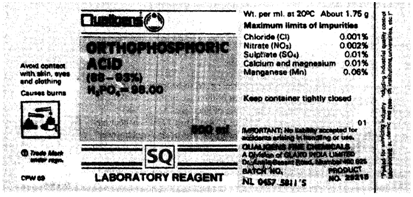Labels and Packaging's : In order to minimise the hazards associated with using a particular substance it is necessary to know what the precise dangers are. The label on the container provides a guide and indicates, for example, whether the substance is flammable, toxic or corrosive. Suppliers of materials to your lab are required by law to conform to the regulations. The regulations cover a wide range of substances including paints and solvents.
So far as packaging is concerned, packages need to meet three basic requirements:
i) All parts of a package must be designed to prevent leakage of the contents when handled normally.
ii) Packaging materials must not be damaged if they come into contact with their contents.
iii) Packages that are intended to be opened and closed repeatedly must be designed so that they do not become worn out after repeated closure.
Labelling is another important aspect in handling of chemical substances. A label must show:
i) The name of the substance. Chemicals must have their IUPAC (International Union of Pure and Applied Chemistry) name as well as their trivial name.
ii) an indication of the general nature of the risk. The corresponding warning symbol must be displayed if the substance is explosive, oxidising, flammable, toxic, harmful, corrosive or irritant.
iii) a risk phrase which underlines and explains the general nature of the risk, and a safety phrase which gives advice about precautions to be taken.
iv) the name and address of the manufacturer.
To illustrate, a typical label is given in Figure.

Figure: A typical label of a reagent bottle.
This information may be sufficient if only small amounts of the material are being used occasionally. However, before carrying out extensive work or purifying a material, reference should be made to published sources to obtain full details of the substance's physical and chemical properties, of its particular hazards. and of the disposal procedure or first aid treatment to adopt in the event of spillage or an accident. The hazards associated with a few of common chemicals are listed at the end of the unit as Annexure. 'Table I summarises hazardous properties of some chemicals encountered in the laboratory and Table summarises the chemicals which give violent reaction when mixed with some other substances i.e. the incompatible chemical substances.